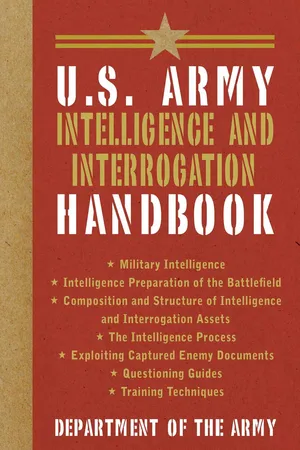
- 384 pages
- English
- ePUB (mobile friendly)
- Available on iOS & Android
About This Book
The U.S. Army Intelligence and Interrogation Handbook provides doctrinal guidance, techniques, and procedures governing the use of interrogators as human intelligence collection agents in support of a commander's intelligence needs. It outlines the interrogator's role within the greater intelligence effort as well as the unit's day-to-day operations, and includes details on how interrogators accomplish their assigned missions. This handbook is intended for use by interrogators as well as commanders, staff officers, and military intelligence personnel charged with conducting interrogations, and applies to operations at all levels of conflict intensity, including conditions involving the use of electronic warfare or nuclear, biological, or chemical weapons.The U.S. Army Intelligence and Interrogation Handbook builds upon existing doctrine and moves interrogation into the twenty-first century within the constraints of the Uniform Code of Military Justice and the Geneva Conventions. Principles, guidelines, and topics covered include: The definition of interrogation
Interrogator capabilities and limitations
Warfighting doctrine
The intelligence cycle, and its disciplines and operations
Amphibious and airborne operations
The interrogation process
Exploiting captured enemy documents
A tactical questioning guide
And many more tactics and techniques used by the U.S. Army!
Frequently asked questions
Information
PART ONE
HUMINT Support, Planning, and Management
Chapter 1
Introduction
INTELLIGENCE BATTLEFIELD OPERATING SYSTEM
INTELLIGENCE PROCESS
- Plan. This step of the intelligence process consists of activities that include assessing the situation, envisioning a desired outcome (also known as setting the vision), identifying pertinent information and intelligence requirements, developing a strategy for ISR operations to satisfy those requirements, directing intelligence operations, and synchronizing the ISR effort. The commander’s intent, planning guidance, and commander’s critical information requirements (CCIRs) (priority information requirements [PIRs] and friendly force information requirements [FFIRs]) drive the planning of intelligence operations. Commanders must involve their supporting staff judge advocate (SJA) when planning intelligence operations (especially HUMINT operations). Planning, managing, and coordinating these operations are continuous activities necessary to obtain information and produce intelligence essential to decisionmaking.
- Prepare. This step includes those staff and leader activities that take place upon receiving the operations plan (OPLAN), operations order (OPORD), warning order (WARNO), or commander’s intent to improve the unit’s ability to execute tasks or missions and survive on the battlefield.
- Collect. Recent ISR doctrine necessitates that the entire staff, especially the G3/S3 and G2/S2, must change their reconnaissance and surveillance (R&S) mindset to conducting ISR. The staff must carefully focus ISR on the CCIR but also enable the quick re-tasking of units and assets as the situation changes. This doctrinal requirement ensures that the enemy situation, not just our OPLAN, “drives” ISR operations. Well-developed procedures and carefully planned flexibility to support emerging targets, changing requirements, and the need to support combat assessment are critical. The G3/S3 and G2/S2 play a critical role in this challenging task that is sometimes referred to as “fighting ISR” because it is so staff intensive during planning and execution (it is an operation within the operation). Elements of all units on the battlefield obtain information and data about enemy forces, activities, facilities, and resources as well as information concerning the environmental and geographical characteristics of a particular area.
- Process. This step converts relevant information into a form suitable for analysis, production, or immediate use by the commander. Processing also includes sorting through large amounts of collected information and intelligence (multidiscipline reports from the unit’s ISR assets, lateral and higher echelon units and organizations, and non-MI elements in the battlespace). Processing identifies and exploits that information which is pertinent to the commander’s intelligence requirements and facilitates situational understanding. Examples of processing include developing film, enhancing imagery, translating a document from a foreign language, converting electronic data into a standardized report that can be analyzed by a system operator, and correlating dissimilar or jumbled information by assembling like elements before the information is forwarded for analysis.
- Produce. In this step, the G2/S2 integrates evaluated, analyzed, and interpreted information from single or multiple sources and disciplines into finished intelligence products. Like collection operations, the G2/S2 must ensure the unit’s information processing and intelligence production are prioritized and synchronized to support answering the collection requirements.

HUMAN INTELLIGENCE
- Conducting source operations.
- Liaising with host nation (HN) officials and allied counterparts.
- Eliciting information from select sources.
- Debriefing US and allied forces and civilian personnel including refugees, displaced persons (DPs), third-country nationals, and local inhabitants.
- Interrogating EPWs and other detainees.
- Initially exploiting documents, media, and materiel.
HUMINT SOURCE
HUMINT COLLECTOR
PHASES OF HUMINT COLLECTION
Planning and Preparation
Approach
Questioning

Termination
Reporting
HUMINT COLLECTION AND RELATED ACTIVITIES
Table of contents
- FRONT COVER
- TITLE PAGE
- COPYRIGHT PAGE
- CONTENTS
- PREFACE
- PART ONE HUMINT SUPPORT, PLANNING, AND MANAGEMENT
- PART TWO HUMINT COLLECTION IN MILITARY SOURCE OPERATIONS
- PART THREE THE HUMINT COLLECTION PROCESS
- PART FOUR ANALYSIS AND TOOLS
- APPENDIX A GENEVA CONVENTIONS
- APPENDIX B SOURCE AND INFORMATION RELIABILITY MATRIX
- APPENDIX C PRE-DEPLOYMENT PLANNING
- APPENDIX D S2 GUIDE FOR HANDLING DETAINEES, CAPTURED ENEMY DOCUMENTS, AND CAPTURED ENEMY EQUIPMENT
- APPENDIX E EXTRACTS FROM ALLIED JOINT PUBLICATION (AJP)-2.5
- APPENDIX F NATO SYSTEM OF ALLOCATING INTERROGATION SERIAL NUMBERS
- APPENDIX G QUESTIONING QUICK REFERENCE
- APPENDIX H SALUTE REPORTING
- APPENDIX I DOCUMENT EXPLOITATION AND HANDLING
- APPENDIX J REFERENCES
- APPENDIX K CONTRACT INTERROGATORS
- APPENDIX L SAMPLE EQUIPMENT FOR HCT OPERATIONS
- APPENDIX M RESTRICTED INTERROGATION TECHNIQUE - SEPARATION
- GLOSSARY
- BIBLIOGRAPHY